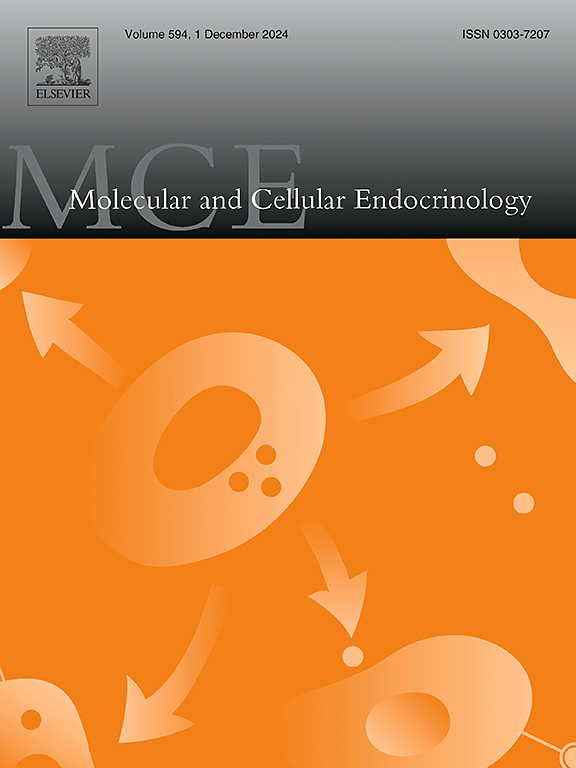利拉鲁肽诱导缺乏生长激素促分泌素受体小鼠食物摄入的增强抑制。
IF 3.6
3区 医学
Q2 CELL BIOLOGY
引用次数: 0
摘要
胰高血糖素样肽-1受体(GLP-1R)和生长激素促分泌素受体(GHSR)在食物摄入方面发挥相反的作用。GLP-1R激活产生强烈的食欲抑制作用,而GHSR激活则强烈刺激食物摄入。在这里,我们验证了阻断GHSR可能影响利拉鲁肽(一种广泛用于治疗糖尿病和肥胖的GLP-1R激动剂)的厌食和减肥作用的假设。我们首先发现,与野生型(WT)对照相比,利拉鲁肽诱导随意喂养的ghsr缺陷小鼠的食物摄入量减少更大,无论性别如何。利拉鲁肽治疗还导致随意喂养的ghsr缺陷小鼠的胃内容物质量大于WT小鼠。有趣的是,ghsr缺陷小鼠下丘脑室旁核(PVH)的GLP-1R免疫标记升高,而propropiomanocortin (POMC)神经元和利拉鲁肽诱导的c-Fos激活的数量(无论是在整个弓形核中还是在POMC神经元中)与WT对照组相比保持不变。利拉鲁肽诱导的ghsr缺陷小鼠侧隔和PVH中c-Fos表达降低。相反,使用JMV2959或内源性拮抗剂/逆激动剂肝脏表达的抗菌肽2对GHSR进行药理学阻断并没有增强利拉鲁肽诱导的食物摄入减少。总之,我们的研究结果表明,基因GHSR缺乏放大了利拉鲁肽的厌食作用,并为这种相互作用背后的神经生物学机制提供了新的见解。这些结果表明,GHSR和GLP-1R系统的双重调节可能代表了一种很有前途的肥胖治疗策略,尽管仔细选择GHSR靶向药物和治疗方案对于优化临床结果至关重要。本文章由计算机程序翻译,如有差异,请以英文原文为准。
Liraglutide induces enhanced suppression of food intake in mice lacking the growth hormone secretagogue receptor
The glucagon-like peptide-1 receptor (GLP-1R) and the growth hormone secretagogue receptor (GHSR) exert opposing effects on food intake. GLP-1R activation produces potent appetite-suppressing effects, whereas GHSR activation strongly stimulates food intake. Here, we tested the hypothesis that blocking GHSR could affect the anorectic and weight-reducing effects of liraglutide, a GLP-1R agonist widely used to treat diabetes and obesity. We first found that liraglutide induced a stronger reduction in food intake in ad libitum-fed GHSR-deficient mice compared to wild-type (WT) controls, regardless of sex. Liraglutide treatment also resulted in greater gastric content mass in ad libitum-fed GHSR-deficient mice than in WT mice. Interestingly, GLP-1R immunolabeling was elevated in the paraventricular nucleus of the hypothalamus (PVH) in GHSR-deficient mice, whereas the number of proopiomelanocortin (POMC) neurons and liraglutide-induced c-Fos activation—either in the entire arcuate nucleus or specifically within POMC neurons—remained unchanged compared to WT controls. Liraglutide-induced c-Fos expression in the lateral septum and PVH was reduced in GHSR-deficient mice. Conversely, pharmacological GHSR blockade using either JMV2959 or the endogenous antagonist/inverse agonist liver-expressed antimicrobial peptide 2 did not enhance liraglutide-induced food intake reduction. In conclusion, our findings reveal that genetic GHSR deficiency amplifies liraglutide's anorectic effects and provide new insight into the neurobiological mechanisms underlying this interaction. These results suggest that dual modulation of the GHSR and GLP-1R systems may represent a promising strategy for obesity treatment, though careful selection of GHSR-targeting agents and therapeutic protocols will be essential to optimize clinical outcomes.
求助全文
通过发布文献求助,成功后即可免费获取论文全文。
去求助
来源期刊

Molecular and Cellular Endocrinology
医学-内分泌学与代谢
CiteScore
9.00
自引率
2.40%
发文量
174
审稿时长
42 days
期刊介绍:
Molecular and Cellular Endocrinology was established in 1974 to meet the demand for integrated publication on all aspects related to the genetic and biochemical effects, synthesis and secretions of extracellular signals (hormones, neurotransmitters, etc.) and to the understanding of cellular regulatory mechanisms involved in hormonal control.
 求助内容:
求助内容: 应助结果提醒方式:
应助结果提醒方式:


